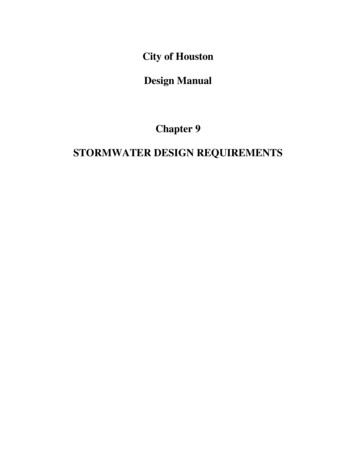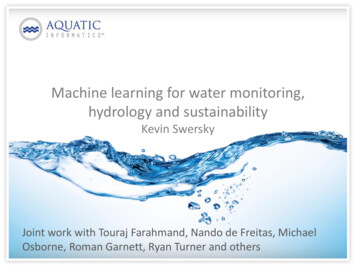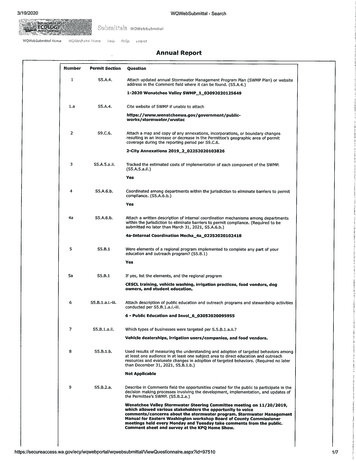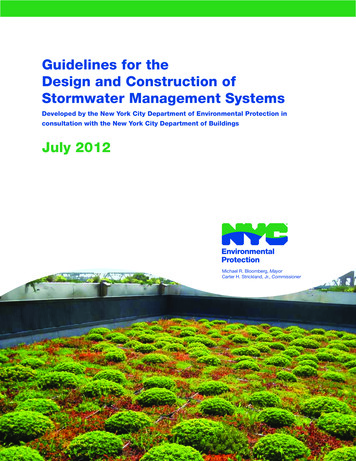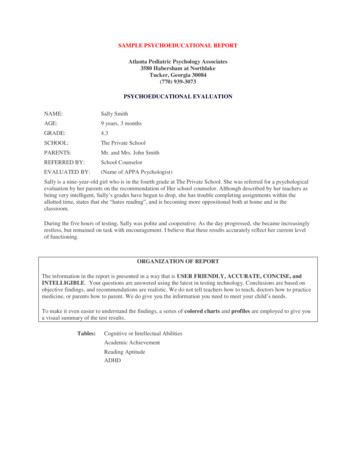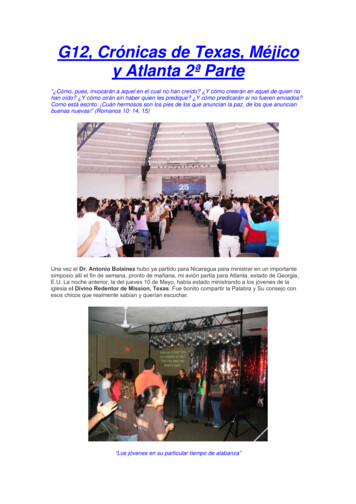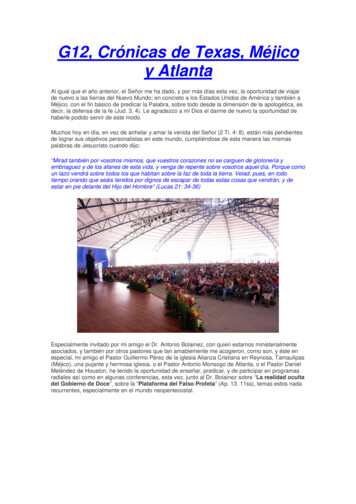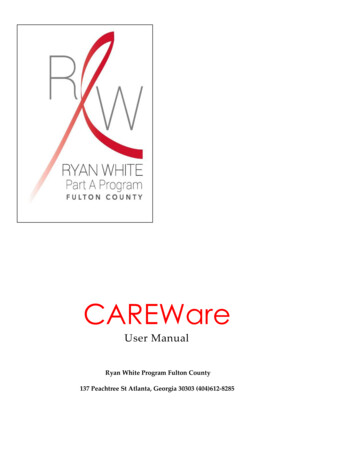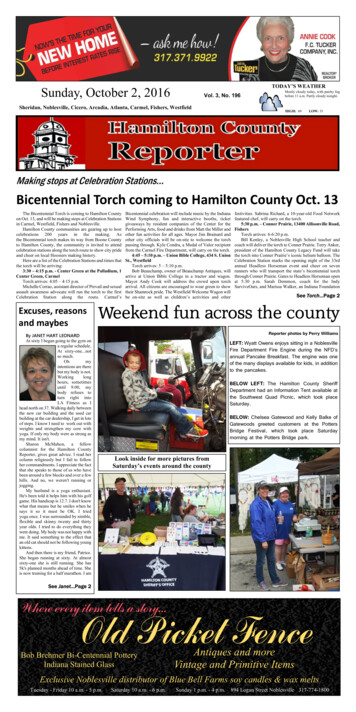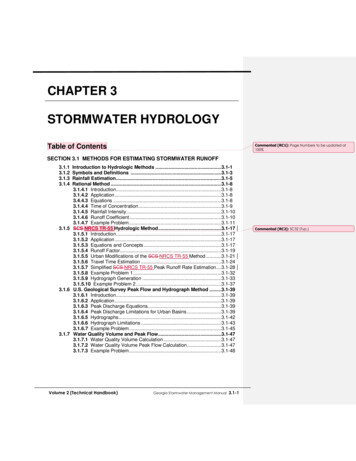
Transcription
CHAPTER 3STORMWATER HYDROLOGYCommented [RC1]: Page Numbers to be updated at100%Table of ContentsSECTION 3.1 METHODS FOR ESTIMATING STORMWATER RUNOFF3.1.13.1.23.1.33.1.4Introduction to Hydrologic Methods .3.1-1Symbols and Definitions .3.1-3Rainfall Estimation .3.1-5Rational Method .3.1-83.1.4.1 Introduction.3.1-83.1.4.2 Application .3.1-83.4.4.3 Equations .3.1-83.1.4.4 Time of Concentration .3.1-93.1.4.5 Rainfall Intensity .3.1-103.1.4.6 Runoff Coefficient.3.1-103.1.4.7 Example Problem .3.1-113.1.5 SCS NRCS TR-55 Hydrologic Method .3.1-173.1.5.1 Introduction.3.1-173.1.5.2 Application .3.1-173.1.5.3 Equations and Concepts .3.1-173.1.5.4 Runoff Factor.3.1-193.1.5.5 Urban Modifications of the SCS NRCS TR-55 Method .3.1-213.1.5.6 Travel Time Estimation .3.1-243.1.5.7 Simplified SCS NRCS TR-55 Peak Runoff Rate Estimation.3.1-283.1.5.8 Example Problem 1 .3.1-323.1.5.9 Hydrograph Generation .3.1-333.1.5.10 Example Problem 2 .3.1-373.1.6 U.S. Geological Survey Peak Flow and Hydrograph Method .3.1-393.1.6.1 Introduction.3.1-393.1.6.2 Application .3.1-393.1.6.3 Peak Discharge Equations.3.1-393.1.6.4 Peak Discharge Limitations for Urban Basins .3.1-393.1.6.5 Hydrographs .3.1-423.1.6.6 Hydrograph Limitations .3.1-433.1.6.7 Example Problem .3.1-453.1.7 Water Quality Volume and Peak Flow .3.1-473.1.7.1 Water Quality Volume Calculation .3.1-473.1.7.2 Water Quality Volume Peak Flow Calculation .3.1-473.1.7.3 Example Problem .3.1-48Volume 2 (Technical Handbook)Georgia Stormwater Management Manual3.1-1Commented [RC2]: SC32 (Typ.)
3.1.8 Water Balance Calculations .3.1-493.1.8.1 Introduction.3.1-493.1.8.2 Basic Equations .3.1-493.1.8.3 Example Problem .3.1-523.1.9 Downstream Hydrologic Assessment .3.1-543.1.9.1 Reasons for Downstream Problems .3.1-543.1.9.2 The Ten-Percent Rule .3.1-553.1.9.3 Example Problem .3.1-56References .3.1-58SECTION 3.2 METHODS FOR ESTIMATING STORMWATER VOLUMEREDUCTION – DESIGN WORKSHEET3.2.1 Volume Reduction DesignIntroduction .3.2-13.2.1.1 Introduction.3.2-13.2.2 XXXXXXXXXX .3.2-53.2.3 XXXXXXXXX .3.2-5SECTION 3.3 STORAGE DESIGN3.3.1 General Storage Concepts.3.3-13.3.1.1 Introduction.3.3-13.3.1.2 Storage Classification .3.3-23.3.1.3 Stage-Storage Relationship .3.3-23.3.1.4 Stage-Discharge Relationship .3.3-43.3.2 Symbols and Definitions .3.3-53.3.3 General Storage Design Procedures .3.3-53.3.3.1 Introduction.3.3-53.3.3.2 Data Needs .3.3-63.3.3.3 Design Procedure .3.3-63.3.4 Preliminary Detention Calculations .3.3-73.3.4.1 Introduction.3.3-73.3.4.2 Storage Volume .3.3-73.3.4.3 Alternative Method .3.3-83.3.4.4 Peak Flow Reduction .3.3-83.3.5 Channel Protection Volume Estimation .3.3-93.3.5.1 Introduction.3.3-93.3.5.2 Basic Approach .3.3-93.3.5.3 Example Problem .3.3-93.3.6 The Modified Rational Method .3.3-123.3.6.1 Introduction.3.3-123.3.6.2 Design Equations .3.3-133.3.6.3 Example Problem .3.3-13References .3.3-16SECTION 3.4 OUTLET STRUCTURES3.4.1 Symbols and Definitions .3.4-13.4.2 Primary Outlets .3.4-13.4.2.1 Introduction.3.4-13.4.2.2 Outlet Structure Types .3.4-23.4.2.3 Orifices .3.4-33.4.2.4 Perforated Risers .3.4-53.4.2.5 Pipes and Culverts .3.4-53.1-2 Georgia Stormwater Management ManualVolume 2 (Technical Handbook)
3.4.2.6 Sharp-Crested Weirs.3.4-63.4.2.7 Broad-Crested Weirs.3.4-73.4.2.8 V-Notch Weirs .3.4-83.4.2.9 Proportional Weirs.3.4-93.4.2.10 Combination Outlets .3.4-103.4.3 Extended Detention (Water Quality and Channel Protection)Outlet Design .3.4-113.4.3.1 Introduction.3.4-113.4.3.2 Method 1: Maximum Hydraulic Head with Routing .3.4-113.4.3.3 Method 2: Average Hydraulic Head and Average Discharge .3.4-123.4.4 Multi-Stage Outlet Design .3.4-123.4.4.1 Introduction.3.4-123.4.4.2 Multi-Stage Outlet Design Procedure .3.4-133.4.5 Extended Detention Outlet Protection .3.4-153.4.6 Trash Racks and Safety Grates.3.4-173.4.6.1 Introduction.3.4-173.4.6.2 Trash Rack Design.3.4-183.4.7 Secondary Outlets .3.4-203.4.7.1 Introduction.3.4-203.4.7.2 Emergency Spillway Design .3.4-20References .3.4-22Commented [RC3]: Table list to be updated at 100%List of TablesTable 2.1.1-1Table 2.1.1-2Table 2.1.2-1Table 2.1.4-1Table 2.1.4-2Table 2.1.5-1Table 2.1.5-2Table 2.1.5-3Table 2.1.5-4Table 2.1.6-1Table 2.1.6-2Table 2.1.6-3Table 2.1.6-4Table 2.1.8-1Table 2.1-8-2Table 2.1.8-3Table 2.1.8-4Table 2.2.2-1Table 2.2.6-1Table 2.3.1-1Table 2.3.2-1Table 2.3.2-2Applications of the Recommended Hydrologic Methods .2.1-2Constraints on Using Recommended Hydrologic Methods.2.1-2Symbols and Definitions .2.1-3Frequency Factors for Rational Formula.2.1-9Recommended Runoff Coefficient Values .2.1-16Runoff Curve Numbers.2.1-22Roughness Coefficients (Manning’s n) for Sheet Flow .2.1-25Ia Values for Runoff Curve Numbers .2.1-29Dimensionless Unit Hydrographs .2.1-35USGS Peak Flow Regression Equations .2.1-40Dimensionless USGS Hydrograph.2.1-42USGS Rural Peak Equations .2.1-44Flood Hydrograph .2.1-46Water Balance Values for Atlanta, Georgia.2.1-50Saturated Hydraulic Conductivity.2.1-51Evaporation Monthly Distribution .2.1-51Summary Information for Austin Acres .2.1-53Symbols and Definitions .2.2-5Rainfall Factors “a” and “b” for the Modified Rational Method(1-year through 100-year return periods) .2.2-14Symbols and Definitions .2.3-1Circular Perforation Sizing .2.3-4Broad-Crested Weir Coefficient (C) Values.2.3-8Volume 2 (Technical Handbook)Georgia Stormwater Management Manual3.1-3
Commented [RC4]: Figure list to be updated at 100%List of FiguresFigure 2.1.3-1Figure 2.1.3-2Figure 2.1.3-3Figure 2.1.4-1Figure 2.1.4-2Figure 2.1.4-3Figure 2.1.5-1Figure 2.1.5-2Figure 2.1.5-3Figure 2.1.5-4Figure 2.1.5-5Figure 2.1.5-6Figure 2.1.5-7Figure 2.1.5-8Figure 2.1.6-1Figure 2.1.8-1Figure 2.1.8-2Figure 2.1.9-1Figure 2.1.9-2Figure 2.1.9-3Figure 2.2.1-1Figure 2.2.1-2Figure 2.2.1-3Figure 2.2.1-4Figure 2.2.1-5Figure 2.2.4-1Figure 2.2.5-1Figure 2.2.5-2Figure 2.2.6-1Figure 2.3.2-1Figure 2.3.2-2Figure 2.3.2-3Figure 2.3.2-4Figure 2.3.2-5Figure 2.3.2-6Figure 2.3.2-7Figure 2.3.2-8Figure 2.3.2-9Figure 2.3.2-10Figure 2.3.4-1Figure 2.3.4-2Figure 2.3.5-1Figure 2.3.5-2Figure 2.3.5-3Figure 2.3.5-4Figure 2.3.6-1Figure 2.3.6-2Figure 2.3.7-1Location of Rainfall Data Sites . 2.1-6Example IDF Curve (Athens, Georgia) . 2.1-6Rainfall Isohyetal Lines (10-year, 24-hour values) . 2.1-7Rational Formula – Overland Time of Flow Nomograph . 2.1-13Manning’s Equation Nomograph . 2.1-14Kinetic Wave Nomograph . 2.1-15Approximate Geographic Boundaries for SCS NRCS TR-55 Rainfall Distributions2.1-18SCS NRCS TR-55 Solution of the Runoff Equation . 2.1-19Composite CN with Connected Impervious Areas . 2.1-23Composite CN with Unconnected Impervious Areas . 2.1-24Average Velocities – Shallow Concentrated Flow. 2.1-27SCSNRCS TR-55 Type II Unit Peak Discharge Graph . 2.1-30SCSNRCS TR-55 Type III Unit Peak Discharge Graph . 2.1-31Dimensionless Unit Hydrographs for Peaking Factors of 484 and 300 . 2.1-35USGS Hydrologic Regions in Georgia. 2.1-41Average Annual Free Water Surface Evaporation (in inches) . 2.1-52Augusta Precipitation Information . 2.1-53Detention Timing Example . 2.1-54Effect of Increased Post-Development Runoff Volume withDetention on a Downstream Hydrograph . 2.1-55Example of the Ten-Percent Rule . 2.1-56Examples of Typical Stormwater Storage Facilities . 2.2-1On-line versus Off-line Storage . 2.2-2Stage-Storage Curve . 2.2-3Double-end Area Method . 2.2-3Stage-Discharge Curve . 2.2-4Triangular-Shaped Hydrographs . 2.2-7Detention Time vs. Discharge Ratios . 2.2-10Approximate Detention Basin Routing for Rainfall Types 1,1A, II, and III . 2.2-10Modified Rational Definitions . 2.2-12Typical Primary Outlets. 2.3-2Orifice Definitions . 2.3-3Perforated Riser . 2.3-3Schematic of Orifice Plate Outlet Structure . 2.3-5Sharp-Crested Weir . 2.3-6Broad-Crested Weir . 2.3-7V-Notch Weir . 2.3-8Proportional Weir Dimensions. 2.3-9Schematic of Combination Outlet Structure . 2.3-10Composite Stage-Discharge Curve . 2.3-10Riser Flow Diagrams . 2.3-14Weir and Orifice Flow . 2.3-15Reverse Slope Pipe Outlet. 2.3-15Hooded Outlet . 2.3-16Half-Round CMP Orifice Hood . 2.3-16Internal Control for Orifice Protection . 2.3-17Example of Various Trash Racks Used on a Riser OutletStructure . 2.3-18Minimum Rack Size vs. Outlet Diameter . 2.3-20Emergency Spillway . 2.3-213.1-4 Georgia Stormwater Management ManualVolume 2 (Technical Handbook)
3.1 METHODS FOR ESTIMATINGSTORMWATER RUNOFF3.1.1 Introduction to Hydrologic MethodsHydrology deals with estimating peak flows, volumes, and time distributions ofstormwater runoff. The analysis of these parameters is fundamental to the design ofstormwater management facilities, such as storm drainage systems and bestmanagement practices. In the hydrologic analysis of a development site, there are anumber of variable factors that affect the nature of stormwater runoff from the site. Someof the factors that need to be considered include: Rainfall amount and storm distributionDrainage area size, shape and orientationGround cover and soil typeSlopes of terrain and stream channel(s)Antecedent moisture conditionStorage potential (floodplains, ponds, wetlands, reservoirs, channels, etc.)Watershed development potentialCharacteristics of the local drainage systemThere are a number of empirical hydrologic methods that can be used to estimate runoffcharacteristics for a site or drainage subbasin; however, the following methods presentedin this section have been selected to support hydrologic site analysis for the designmethods and procedures included in the Manual: Rational MethodSCSNRCS TR-55 Unit Hydrograph MethodU.S. Geological Survey (USGS) Regression EquationsWater Quality Treatment Volume CalculationWater Balance CalculationsThese methods were selected
Volume 2 (Technical Handbook) Georgia Stormwater Management Manual 3.1-5 3.1 METHODS FOR ESTIMATING STORMWATER RUNOFF 3.1.1 Introduction to Hydrologic Methods Hydrology deals with
